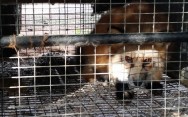The Slaughter of Wild Horses Must End
The slaughter of wild horses is one of the most significant attacks on animals in the US. It hides in plain sight under cover of the BLM’s policy to round up and re-home horses. Animal advocates have obtained documents that show that instead of being adopted, thousands of horses are sold to slaughterhouses.
The slaughter of wild horses is also part of a bigger story about how the US fails to protect horses and willingly allows healthy horses with many happy years of life left to be sold into slaughter.
These problems are connected to the substantial export of horses internationally from the US. The export of horses makes the fate of horses sold into slaughter even more cruel. On top of being violently slaughtered, horses transported internationally have to endure grueling journeys.
Since the practice of slaughtering horses is no longer supported in the US (even if it is technically still legal), horses are exported to Mexico and Canada to be slaughtered. Even if it’s no longer legal to kill horses for meat in the US, the animals can still be sold in the US and exported elsewhere.
So how did wild horses, which should be protected by the 1971 Horses and Burros Act, come to be sold in “kill pens” and transported miles to be slaughtered? The answer is that the Bureau of Land Management’s adoption incentive program isn’t working.
The BLM introduced their adoption incentive program in 2019. The program pays people $1000 to adopt a horse. After the release of a report from The American Wild Horse Campaign in 2021 and a New York Times investigation that showed that hundreds of wild horses were being re-sold to slaughter, the BLM tweaked their adoption policy to include stricter background checks and checks on a horse’s well being. Yet in 2022, a report from The American Wild Horse Campaign found that the problem persisted. A large number of horses were still being sold into slaughter, and the number of horses being sent to slaughter was likely much higher than estimated. Reports by the AWHC found that a coordinated group of people were adopting wild horses and making up to $80,000 by selling the horses into slaughter.
The BLM’s policies of rounding up horses are also generally criticized. Reducing herds to protect ecosystems and saving horses from dying of starvation in drought ridden conditions may be reasonable motivations, but the BLM is also influenced by the interests of livestock farmers competing for resources with the horses. There are many ways around this problem that don’t involve separating horses from the herd and rounding them up. Groups who represent horses are also asking the BLM to re-assess their methods for corralling wild horses for adoption.
The method of rounding up by helicopter would be eliminated by a bill introduced in Congress, The Wild Horse and Burro Protection Act of 2022. The bill would also employ more cowboys to round up the horses and explore humane alternatives to protect horses. For example, some groups have had success with fertility methods to control population. In this way the horses are not separated from their family groups, and they are not snatched in traumatizing round-ups and corralled in conditions that may be unsafe, exposing them to disease, only to be sold into slaughter.
The slaughter of wild horses is part of a broader problem that affects all horses. The problem is that the market for horse slaughter still exists in the US. The ugliness of horse slaughter itself has been exported, while selling horses into slaughter is openly acceptable.
To learn how to get involved in stopping the slaughter of wild horses and all horses in America, visit the websites of horse advocacy organizations such as the AWHC to find out how to support horses. Contact your local animal rights advocacy groups and local representatives to support the passage of the SAFE Act which will permanently ban horse slaughter in the US and the Wild Horse and Burro Protection Act which will require the BLM to update their policies to protect wild horses.








Social Media